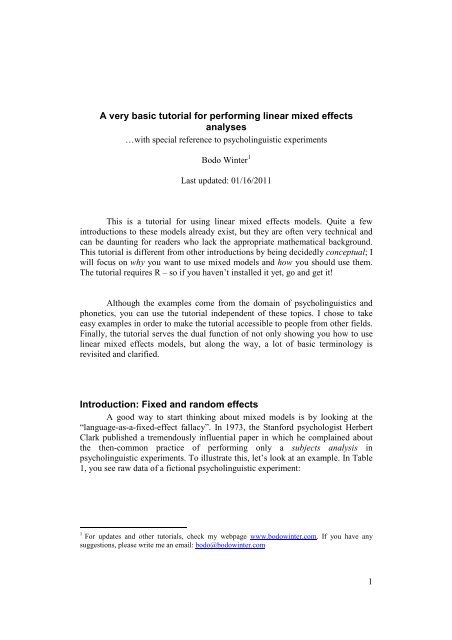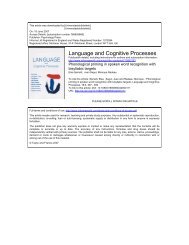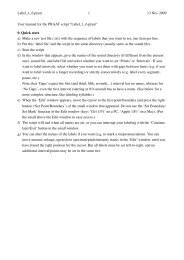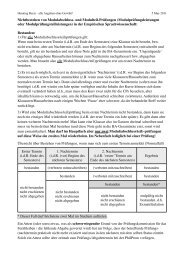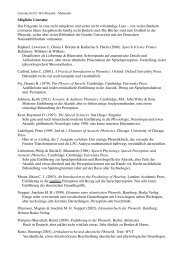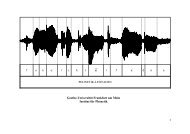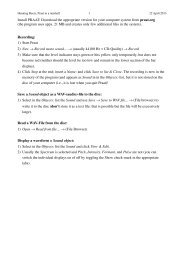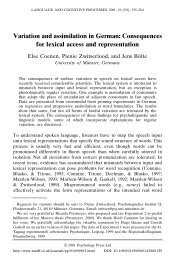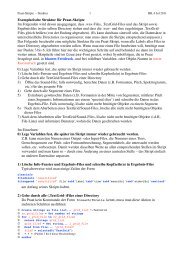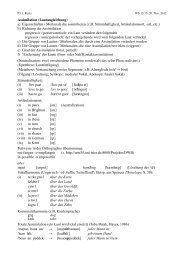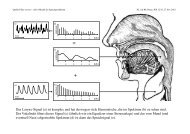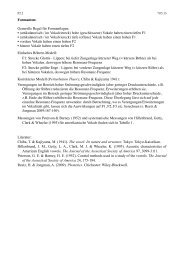A very basic tutorial for performing linear mixed
A very basic tutorial for performing linear mixed
A very basic tutorial for performing linear mixed
You also want an ePaper? Increase the reach of your titles
YUMPU automatically turns print PDFs into web optimized ePapers that Google loves.
A <strong>very</strong> <strong>basic</strong> <strong>tutorial</strong> <strong>for</strong> per<strong>for</strong>ming <strong>linear</strong> <strong>mixed</strong> effects<br />
analyses<br />
…with special reference to psycholinguistic experiments<br />
Bodo Winter 1<br />
Last updated: 01/16/2011<br />
This is a <strong>tutorial</strong> <strong>for</strong> using <strong>linear</strong> <strong>mixed</strong> effects models. Quite a few<br />
introductions to these models already exist, but they are often <strong>very</strong> technical and<br />
can be daunting <strong>for</strong> readers who lack the appropriate mathematical background.<br />
This <strong>tutorial</strong> is different from other introductions by being decidedly conceptual; I<br />
will focus on why you want to use <strong>mixed</strong> models and how you should use them.<br />
The <strong>tutorial</strong> requires R – so if you haven’t installed it yet, go and get it!<br />
Although the examples come from the domain of psycholinguistics and<br />
phonetics, you can use the <strong>tutorial</strong> independent of these topics. I chose to take<br />
easy examples in order to make the <strong>tutorial</strong> accessible to people from other fields.<br />
Finally, the <strong>tutorial</strong> serves the dual function of not only showing you how to use<br />
<strong>linear</strong> <strong>mixed</strong> effects models, but along the way, a lot of <strong>basic</strong> terminology is<br />
revisited and clarified.<br />
Introduction: Fixed and random effects<br />
A good way to start thinking about <strong>mixed</strong> models is by looking at the<br />
“language-as-a-fixed-effect fallacy”. In 1973, the Stan<strong>for</strong>d psychologist Herbert<br />
Clark published a tremendously influential paper in which he complained about<br />
the then-common practice of per<strong>for</strong>ming only a subjects analysis in<br />
psycholinguistic experiments. To illustrate this, let’s look at an example. In Table<br />
1, you see raw data of a fictional psycholinguistic experiment:<br />
1 For updates and other <strong>tutorial</strong>s, check my webpage www.bodowinter.com. If you have any<br />
suggestions, please write me an email: bodo@bodowinter.com<br />
1
Table 1: Raw data from a psycholinguistic experiment<br />
Subject Item Condition Reaction Time<br />
Frank “car” A 400ms<br />
Frank “car” B 500ms<br />
Frank “elephant” A 440ms<br />
Frank “elephant” B 750ms<br />
… … … …<br />
Peter “car” A 430ms<br />
Peter “car” B 520ms<br />
…<br />
There are several different subjects and each subject responded to multiple<br />
words (=items). Each item was presented in two contexts (A and B) – let’s say<br />
that these were the critical conditions the experimenter was interested in. Now, by<br />
just looking at the raw data, we can already guess that in condition B, people<br />
responded somewhat slower than in A. To show that this difference between A<br />
and B is consistent across different subjects, people would per<strong>for</strong>m a subjects<br />
analysis. How would they do it? The first step would be to re-order the data by<br />
taking means by subject such as in table 2:<br />
Table 2: Data from the naming experiment by subjects<br />
Subject Condition A Condition B<br />
Frank 400ms 450ms<br />
Peter 500ms 600ms<br />
…<br />
Now, each row is not a single data entry but a summary of all of a<br />
particular subject’s responses. Frank’s “A” cell is filled with the mean of all of his<br />
responses in the A condition, and his “B” cell is filled with the mean of all of his<br />
responses in the B condition. If all of the other subjects behaved in a similar way,<br />
then a paired t-test run over this dataset would probably indicate a significant<br />
difference between condition A and B: it seems as if people responded slower in<br />
condition B.<br />
However, we have to bear in mind that by taking the mean of a subject’s<br />
responses to different items in condition A and condition B, we’re essentially<br />
reducing the data – we’re getting rid of the distribution that is underlying the<br />
different responses of a particular subject. Because of this, it could actually be the<br />
case that the difference between condition A and condition B seen in table 2 is<br />
only driven by a few items. If you look at “case 1” and “case 2” below, you’ll see<br />
that the mean can be the same even though the underlying distributions look <strong>very</strong><br />
different.<br />
2
Case 1<br />
400 400 400 400 mean: 400<br />
Case 2<br />
200 200 200 1000 mean: 400<br />
Because both “case 1” and “case 2” are likely possibilities, and because<br />
table 2 does not allow us to see with which of these cases we’re dealing, we need<br />
to construct a different table, one where we take the means by items:<br />
Table 3: Data from our experiment with means by items<br />
Item Condition A Condition B<br />
“car” 220ms 210ms<br />
“elephant” 230ms 1000ms<br />
“pig” 190ms 200ms<br />
“truck” 200ms 200ms<br />
...<br />
Here, we’re essentially ignoring the subject in<strong>for</strong>mation. And in this<br />
hypothetical example, we can indeed see that the difference between A and B that<br />
was observed in the subjects analysis was due to just a few items. It seems to be<br />
the case that the one extreme value in condition B, the 1000ms response to the<br />
word “elephant” influenced the pattern that we observed by looking at the data by<br />
subjects. If we were to run a paired t-test on this dataset, it would probably not<br />
indicate a significant difference…<br />
This example highlights that looking at data by subjects or by items can<br />
lead to vastly different conclusions. One of Herbert Clark’s main contributions<br />
was to highlight the importance of the items analysis, and similar arguments have<br />
been made in other fields than just psycholinguistics.<br />
Now, it’s time to introduce some new terminology that will later help us<br />
with the <strong>linear</strong> <strong>mixed</strong> effects models. When we did the subjects analysis, we took<br />
“Subjects” as a random effect. Basically this means that we expect random<br />
variation from each subject, because after all, e<strong>very</strong>body will have slightly<br />
different reaction times based on a various reasons that we can’t control in our<br />
experiments (e.g. some people are just slower than others, some subjects might be<br />
stoned when appearing to your experiment etc.). When we did the items analysis,<br />
we took “Items” as a random effect. Each word has a range of different features<br />
that might affect reaction times (frequency, word class, word length etc.), some of<br />
which we won’t be able to control in our experiment. From the perspective of the<br />
experiment, both subjects and items will influence the reaction times in a way that<br />
is – at least to some extent – unpredictable or “random”. Things that induce some<br />
3
amount of random variation into your data, statisticians like to call “random<br />
effects”.<br />
The counter-term to “random effect” is “fixed effect”. Things that you<br />
control in your experiment, where you predict or expect a certain systematic<br />
difference between conditions are called “fixed effects” or “factors”. Fixed effects<br />
can be categorical and discontinuous (e.g. male vs. female) or numerical and<br />
continuous (e.g. articulation rate).<br />
So, be<strong>for</strong>e we go on to the actual <strong>linear</strong> <strong>mixed</strong> effects models, let’s just see<br />
what happened in response to Clark’s paper. In the end, his critique led to the<br />
requirement that whenever you present multiple items to each subject, you have to<br />
per<strong>for</strong>m a subjects analysis and an items analysis. There<strong>for</strong>e, you’ll find in almost<br />
all psycholinguistic publications that two test statistics are reported, e.g. F1 and F2<br />
(ANOVA) or t1 and t2 (t-test). A result could read something like this:<br />
Or simply:<br />
“We obtained a significant effect of Frequency <strong>for</strong> both subjects<br />
(F1(32)=16.43, p=0.0043) and items (F2(16)=5.78, p=0.0032).”<br />
“We obtained a significant effect of Frequency (F1(32)=16.43, p=0.0043;<br />
F2(16)=5.78, p=0.0032).”<br />
The subscript 1 stands <strong>for</strong> the subjects analysis, the subscript 2 stands <strong>for</strong><br />
the items analysis. Usually, it is required that both test statistics are significant<br />
(see Raaijmakers et al. 1999 <strong>for</strong> a critique of this standard). If, <strong>for</strong> example, the<br />
subjects analysis reaches an accepted significance level such as α=0.05 but the<br />
items analysis does not, then this might indicate that only a few individual items<br />
lead to the effect observed in the subjects analysis. In other words, you could say<br />
the effect does not generalize over items.<br />
Now, <strong>mixed</strong> models improve upon the common practice of doing separate<br />
tests <strong>for</strong> subjects and items by allowing you to combine random effects. In essence,<br />
this means that you can generalize across both subjects and items with a single<br />
model. So, you don’t need to do two separate statistical tests anymore. Mixed<br />
models have several other advantages:<br />
1. You can include categorical and numerical predictor variables in your<br />
experiment. For example, you could test the combined effect of the<br />
fixed effects Articulation Rate (numerical/continuous) and Gender<br />
(categorical/discontinuous) on a set of measures you’ve done.<br />
2. You can use <strong>mixed</strong> models <strong>for</strong> both categorical/discontinuous and<br />
numerical/continuous data. For example, you can predict the<br />
4
occurrence of a yes response (categorical/discontinuous), as well as<br />
reaction times and other numerical/continuous dependent measures.<br />
Sounds cool? So let’s do it! In the following, I present to you how to use<br />
<strong>mixed</strong> models in R. For this, you need to have R installed.<br />
Linear <strong>mixed</strong> effects models in R<br />
For a start, we need to install the R packages lme4 (Bates & Maechler,<br />
2009) and languageR (Baayen, 2009; cf. Baayen, 2008). While being connected<br />
to the internet, open R and type in:<br />
install.packages( )<br />
Select a server close to you and then choose the packages lme4 and<br />
languageR. In order to be able to use the packages, you have to load them into the<br />
R environment with the following command:<br />
library(lme4);library(languageR)<br />
Now, you have several new commands available to you, among them<br />
lmer( ), which is the <strong>basic</strong> command <strong>for</strong> per<strong>for</strong>ming <strong>mixed</strong> effects models<br />
provided by the lme4 package, and pvals.fnc( ), which is the a command <strong>for</strong><br />
getting p-values from <strong>mixed</strong> models provided by the languageR package.<br />
To go on, we need some data. For this <strong>tutorial</strong>, I’m using a dataset that is<br />
available on: http://www.bodowinter.com/<strong>tutorial</strong>/politeness_data.csv<br />
This is a shortened version of a dataset that was used <strong>for</strong> Grawunder &<br />
Winter (2010) and Winter & Grawunder (submitted). Put the data into your /bin/<br />
folder where you’ve installed R. Then, load the data into R:<br />
politeness
With this data (which is from Korean speakers, by the way), we were<br />
interested in the phonetic difference between polite and in<strong>for</strong>mal speech. Whether<br />
a given response was in the polite or the in<strong>for</strong>mal condition is given in the column<br />
“attitude”. The dependent measure in this example is voice pitch given in the<br />
column called “frequency”. The units of frequency are given in Hertz (Hz). One<br />
last thing: you need to know that we took repeated measures from each subject,<br />
meaning that each subject was presented multiple context scenarios in the polite<br />
and in<strong>for</strong>mal condition. The number of the context scenario is given in the column<br />
“scenario”.<br />
Because the three most important rules of statistics are “Draw a picture,<br />
draw a picture, draw a picture” (Michael Starbird), let’s make a boxplot be<strong>for</strong>e we<br />
start constructing <strong>mixed</strong> models. In fact, be<strong>for</strong>e you do any inferential statistics<br />
you should always explore the data extensively.<br />
boxplot(frequency ~ attitude, data=politeness)<br />
100 150 200 250 300<br />
inf pol<br />
It looks like the voice pitch was lower in the polite condition. This is<br />
important because – be<strong>for</strong>e we do any statistical tests – we can <strong>for</strong>mulate the<br />
expectation that the <strong>mixed</strong> model will show (if anything) a lowering of voice<br />
pitch in the polite condition. Let’s also look at the medians of the two conditions.<br />
median(politeness[which(politeness$attitude=="pol"<br />
),]$frequency, na.rm=T)<br />
median(politeness[which(politeness$attitude=="inf"<br />
),]$frequency)<br />
6
The reason why the first command includes the additional argument<br />
na.rm=T is that R is reluctant to give you a median value if there is a missing<br />
value, and as we pointed out be<strong>for</strong>e, there is a missing value in the polite<br />
condition in line 263.<br />
The median( ) commands give you the median 185.5 Hz <strong>for</strong> the polite<br />
condition and the median of 209.05 Hz <strong>for</strong> the in<strong>for</strong>mal condition. So, there seems<br />
to be a difference of about 23.55 Hz. Now, let’s see whether this difference<br />
between the polite and the in<strong>for</strong>mal condition depends on whether the speaker is<br />
male or female; let’s add the factor Gender to our boxplot.<br />
boxplot(frequency ~ attitude*gender,<br />
data=politeness)<br />
100 150 200 250 300<br />
inf.F pol.F inf.M pol.M<br />
What do we see? Well, the results <strong>for</strong> females and males do not look<br />
qualitatively different from each other: in both cases the voice pitch is lower in<br />
the polite condition. So, just by looking at this boxplot, there does not seem to be<br />
an interaction between the factors Politeness and Gender. Again, this is important<br />
<strong>for</strong> <strong>for</strong>mulating expectations with respect to your <strong>mixed</strong> effects analysis. It cannot<br />
be emphasized enough how important it is to look at the data extensively be<strong>for</strong>e<br />
you start doing an analysis.<br />
Now, let’s start building a model. By doing so, we’re leaving the domain<br />
of descriptive statistics (summarizing and displaying data) and we enter the<br />
domain of inferential statistics (testing whether the differences that we saw with<br />
descriptive statistics are chance results or not). By doing inferential statistics such<br />
7
as <strong>linear</strong> <strong>mixed</strong> effects models, we want to know whether the difference in voice<br />
pitch between the polite and the in<strong>for</strong>mal condition are due to chance…<br />
We will now use the function lmer( ). This command takes as its first<br />
argument a <strong>for</strong>mula <strong>very</strong> similar to the one we used in the boxplot( ) command.<br />
When we created the boxplots, we displayed frequency values with respect to the<br />
factor attitude, now we want to predict frequency values with respect the factor<br />
attitude. So, to the left of the tilde we put the thing that we seek to explain or<br />
predict, the dependent measure. To the right of the tilde, we put the fixed effect<br />
that we use to predict pitch, the predictor variable or the fixed effect. In the<br />
example below, there’s no random effect and if you type in the command, you<br />
will retrieve an error:<br />
lmer(frequency ~ attitude, data=politeness)<br />
The reason <strong>for</strong> this error is that the <strong>linear</strong> <strong>mixed</strong> effect model needs a<br />
random effect. So we need to introduce a random effect, and the way this is done<br />
is a little bit cryptic:<br />
(1|subject)<br />
… means “Subject as a random effect” and likewise<br />
(1|item)<br />
… means “Item as a random effect”.<br />
In our example, the items are scenarios. There<strong>for</strong>e, the command that we<br />
need to use is:<br />
politeness.model = lmer(frequency ~ attitude +<br />
(1|subject) + (1|scenario), data=politeness)<br />
With this command, we created a model that predicted frequency based on<br />
the fixed effect “attitude” and the random effects “subject” and “scenario”, and<br />
we saved this model in the object politeness.model. Type in politeness.model and<br />
see what it gives you. Among other things, you see a t-value <strong>for</strong> the fixed effect<br />
which is -2.547. t-values approaching 2 or -2 usually reach significance if there’s<br />
enough data. Usually, you would now look on a table (or use your computer) to<br />
find the p-value associated with that specific t-value. However, that’s not possible<br />
in this case because you don’t know the degrees of freedom. So, how can we<br />
assess the statistical significance of the results? Harald Baayen developed a<br />
function pvals.fnc( ) that gives you p-values based on Markov-chain Monte Carlo<br />
sampling, so called MCMC-estimated p-values.<br />
8
politeness.model.p = pvals.fnc(politeness.model)<br />
By typing in the above expression, you calculate the p-values based on the<br />
model that is saved in the object politeness.model. The p-values are saved in the<br />
object politeness.model.p. Type in the name of this object to see the following<br />
results:<br />
Right now, let’s only look at the p-values <strong>for</strong> the fixed effects and not at<br />
the random effects (later on, you can access only the fixed effects by typing in<br />
politeness.model.p$fixed). So, what do we see? There are two rows, one is called<br />
“(Intercept)” and one is called “attitudepol”. Then, there are several columns of<br />
which the two most important are “Estimate” and “pMCMC”. Let’s look at<br />
“attitudepol” first. “Attitudepol” is an abbreviation <strong>for</strong> “the polite level of the<br />
factor Attitude” (as opposed to the level in<strong>for</strong>mal). In the “Estimate” column, you<br />
see -19.19, which is actually a numerical value of our measurement (frequency in<br />
Hertz). So, the table says that <strong>for</strong> the polite condition (as opposed to the in<strong>for</strong>mal<br />
condition), you need to decrease frequency by 19.19 Hz. In the pMCMC, you see<br />
the value 0.0460. This is the MCMC-estimated p-value. So, by a standard α-level<br />
of 0.05, this result is significant … which means that it is relatively unlikely due<br />
to chance.<br />
Now, the row “(Intercept”) indicates your “starting point”. If you think<br />
back to high school math, the intercept refers to the value where a line meets the<br />
y-axis of a plot:<br />
y-intercept<br />
9
The model takes the mean of all data points as the value that it would<br />
estimate “to start with”. Then, all the other effects are predicted on the basis of<br />
this starting value, e.g. to arrive at a good estimate of pitch in the polite condition,<br />
you have to decrease the mean by 19 Hz.<br />
In our example, the intercept has the estimate 192.05 Hz. This is the mean<br />
of all frequencies taken together, including both males and females. Since males<br />
have relatively low Hertz values and females relatively high Hertz values, you<br />
end up with a mean that is between the two. This is a classic example of a<br />
bimodal distribution, a distribution that has two modes (=the most frequent value).<br />
To see this, compare the mean of the complete dataset:<br />
mean(politeness$frequency, na.rm=T)<br />
To the mean of the mean of the male and female subsets:<br />
mean(politeness[which(politeness$gender ==<br />
"F"),]$frequency)<br />
mean(politeness[which(politeness$gender ==<br />
"M"),]$frequency, na.rm=T)<br />
In some way, an intercept of 192.05 Hz does not make much sense. This is<br />
similar to the classic example of a farm with a dozen hens and a dozen cows ….<br />
where, if you were to take the arithmetic mean number of legs on the farm, you<br />
would make the meaningless statement that the animals of the farm have on<br />
average three legs. So, we should in<strong>for</strong>m our model that multiple genders are<br />
present in our data and that there<strong>for</strong>e, vast differences in voice pitch are to be<br />
expected. Currently, our model does not account <strong>for</strong> Gender.<br />
Should Gender be a fixed or a random effect? Some people might be<br />
tempted to put “gender” as a random effect because they want to “generalize<br />
over” genders… however, this is not a good idea because the variation in<br />
frequencies that you expect to come from male and female participants is not<br />
“random” but in fact quite systematic and predictable. So we want to add gender<br />
as a fixed effect, as if we were doing a controlled experiment with four<br />
conditions: male|polite, male|in<strong>for</strong>mal, female|polite and female|in<strong>for</strong>mal. What<br />
we’re interested in is not only the effect of gender on frequencies in general, but<br />
also on the effect of gender on frequencies with respect to politeness. We can test<br />
this by adding gender to the model and putting a * between the fixed effects<br />
gender and politeness. This * says to the model that we’re not only interested in<br />
the fixed effect gender and the fixed effect politeness, but also in the interaction<br />
of these two factors.<br />
10
politeness.model = lmer(frequency ~<br />
attitude*gender + (1|subject) + (1|scenario),<br />
data=politeness)<br />
politeness.model.p = pvals.fnc(politeness.model)<br />
Note that you’ve overwritten the model and the p-value output object of<br />
the first <strong>mixed</strong> model analysis that we per<strong>for</strong>med. Check the results by typing<br />
politeness.model.p$fixed.<br />
What do we see? The intercept is 256 Hz (the mean frequency of the<br />
female participants…). So the model takes the voice pitch of females as the<br />
starting value. Why does it take the females and not the males? If you type in the<br />
following…<br />
levels(politeness$gender)<br />
… you see that “F” <strong>for</strong> female is listed be<strong>for</strong>e “M”. The model simply<br />
takes the first level of a factor as the intercept.<br />
The fact that the intercept reaches significance (p < 0.0001) simply means<br />
that the intercept is significantly different from 0. It usually does not matter much<br />
if the intercept is significant or not.<br />
Now, to accurately predict the frequency of the polite condition as<br />
opposed to the frequency of the in<strong>for</strong>mal condition, you need to lower the<br />
frequencies by 29.27 Hz. This result is unlikely due to chance as indicated by the<br />
low p-value (p=0.0122). Then, with respect to gender, you need to lower<br />
frequencies by 127.94 Hz <strong>for</strong> males. As we would expect, this difference is<br />
unlikely due to chance as well (p=0.0008). The “attitudepol” and “genderM” rows<br />
indicate so-called main effects (you only consider the effect of a single factor).<br />
The last column “attitudepol:genderM” indicates an interaction effect because it<br />
includes two factors. Whenever you include an interaction effect into your model<br />
with *, the model will automatically compute the corresponding main effects as<br />
well.<br />
The estimate of the interaction effect is a little bit difficult to read: “<strong>for</strong> the<br />
polite condition you need to go up by 20.38 Hz <strong>for</strong> males”. Interaction effects are<br />
often difficult to read and in order to see in which direction the effect is going,<br />
11
you usually need to make extra graphs and tests rather than looking at the<br />
estimates output of the <strong>mixed</strong> models. Crucially however, the <strong>mixed</strong> model<br />
confirms an expectation that we had by looking at boxplot 2: The interaction<br />
between attitude and gender is not significant (p=0.1916), meaning that whatever<br />
interaction there is in the dataset right now is likely due to chance. We expected<br />
this result based on boxplot 2 where we didn’t see a big difference of polite vs.<br />
in<strong>for</strong>mal <strong>for</strong> males and females.<br />
However, what would happen if there were a significant interaction effect?<br />
In this case, the usual approach is to per<strong>for</strong>m a number of pairwise comparisons<br />
(e.g. male|polite vs. female|polite, male|polite vs. male|in<strong>for</strong>mal etc.) with t-tests<br />
or Wilcoxon tests. A significant interaction only tells you that two factors interact;<br />
to get at the direction of the interaction, visualization of the interaction (e.g.<br />
boxplots), as well as a series of individual tests is needed. These tests, as well as<br />
the necessary corrections <strong>for</strong> multiple comparisons (e.g. Bonferroni correction,<br />
Dunn Sidak correction) might well be the topic of another <strong>tutorial</strong> and there’s<br />
actually several other texts on this – I un<strong>for</strong>tunately can’t cover them here.<br />
So far, so cool. We see that attitude has a significant influence on<br />
frequency and so does gender, but these two factors don’t interact. However, we<br />
need to check some extra things. In particular, two things ALWAYS need to be<br />
done when using <strong>linear</strong> <strong>mixed</strong> effects models:<br />
1. you need to check <strong>for</strong> normality and homogeneity<br />
2. you need to construct a so-called “null model” and compare the<br />
per<strong>for</strong>mance of your <strong>mixed</strong> model to this null model<br />
Let’s address the first one first. Mixed effects models belong to the family<br />
of parametric statistical techniques (together with such tests as t-tests and<br />
ANOVAs). Parametric approaches require the difference between the conditions<br />
to be normally distributed, i.e. the differences between condition A and condition<br />
B need to approximate a bell-shaped curve. Non-parametric techniques do not<br />
have this restriction – they are “distribution-free” –, however, <strong>mixed</strong> models are<br />
parametric and there<strong>for</strong>e we need to check whether the differences actually follow<br />
the normal curve. Another requirement of <strong>mixed</strong> models is that the data is<br />
homogenous, namely that one part of your dataset is not vastly different from<br />
another with respect to e.g. variance.<br />
There are several separate tests <strong>for</strong> homogeneity and normality, but the<br />
way <strong>mixed</strong> models are implemented in R, we can easily check both of these<br />
requirements visually without having to per<strong>for</strong>m any extra tests. To do this, we<br />
will inspect so-called “residual plots”. This plot depicts fitted values on the x-axis<br />
and residuals on the y-axis. “Fitted value” is simply another word <strong>for</strong> the value<br />
12
that the model predicts, and a “residual” is the deviance of a predicted value from<br />
the actually observed value (= the error). This is how we get the plot:<br />
plot(fitted(politeness.model),residuals(politeness<br />
.model))<br />
residuals(politeness.model)<br />
-40 -20 0 20 40 60 80<br />
100 150 200 250<br />
fitted(politeness.model)<br />
Now, what do we see? Well, we have the predicted values of voice pitch<br />
on the x-axis and the residuals on the y-axis. So the y-axis represents how much is<br />
left over if you take the difference of the fitted value and the actually observed<br />
value. Although somewhat difficult to see with so few values, there are two<br />
clouds in the plot… one to the right on the x-axis in the range of ~200-270 Hz,<br />
and one to the left in the range of ~90-160 Hz, with a small gap between these<br />
two. These two clouds are the responses from the female and the male subjects<br />
respectively.<br />
Other than these two clouds, there does not seem to be a particular pattern.<br />
More importantly, there does not seem to be any indication of a <strong>linear</strong> trend – try<br />
to mentally fit a line through the dataset and you will see that the best line is<br />
probably a straight line going from left to right with a lot of spread around the line.<br />
The spread indicates that if we take a particular point on the x-axis, it’s difficult to<br />
say where you will lie on the y-axis. And <strong>for</strong> our residuals, that’s exactly what we<br />
want.<br />
Let’s think about what it would mean if you saw a <strong>linear</strong> trend with a<br />
downwards going slope:<br />
13
not good<br />
Such a <strong>linear</strong> trend would mean that the error of the model (the difference<br />
between observed and fitted values) is in some way systematic. On the figure<br />
above, lower fitted values have residuals that are more towards the 0 line. Higher<br />
fitted values are consistently more off, so the model is more wrong with larger<br />
values. So, ideally what you want is something that is akin towards a horizontal<br />
line.<br />
In the case of the above graph, the data is somehow not homogenous<br />
maybe because one part of the data is more variable than another. If that is the<br />
case, you might need to trans<strong>for</strong>m the data in order to make it meet the<br />
assumptions that are necessary <strong>for</strong> <strong>mixed</strong> models. Again, trans<strong>for</strong>mations (e.g.<br />
logarithmic, quadratic, inverse trans<strong>for</strong>mations) are a pretty big topic that I cannot<br />
cover in this text. However, I do intend to write a <strong>tutorial</strong> on data cleaning with R<br />
in which a lot of trans<strong>for</strong>mations will be covered.<br />
To sum up this section: whenever you check the residual plots, check <strong>for</strong><br />
visual patterns. If there’s no pattern and more importantly, if there are no <strong>linear</strong><br />
trends, then your data is o.k. with respect to homogeneity and normality.<br />
Now, we need to do one last thing. We need to check whether our model<br />
(“politeness.model”) per<strong>for</strong>ms significantly better than a null model. A null model<br />
is a model that includes only the random effects and not the fixed effects we’re<br />
interested in. You can think of this as a kind of “sanity check” in which we assess<br />
whether our fixed effects have any merit at all. The null model below has a single<br />
fixed effect “1”.<br />
politeness.null = lmer(frequency ~ 1 + (1|subject)<br />
+ (1|scenario), data=politeness)<br />
14
Then, we per<strong>for</strong>m a so-called likelihood ratio test with the anova( )<br />
command. We simply put the test model as one argument and the null model as<br />
the other:<br />
anova(politeness.model, politeness.null)<br />
The result is a relatively low p-value of 0.00047, indicating that the<br />
difference between the models is unlikely due to chance… in other words: our<br />
model makes a difference and the results obtained by our model actually matter!<br />
If the likelihood ratio test would not reach significance, you should reject your<br />
results and not report them.<br />
Writing up your results<br />
You might have wondered that with the <strong>linear</strong> <strong>mixed</strong> effects analyses that<br />
we’ve per<strong>for</strong>med so far, our results were only p-values and there were no test<br />
statistics (such as t-values or F-values), and there were no degrees of freedom.<br />
This is a problem because most journal publications require you to report at least<br />
three things: 1. the test statistics, 2. the degrees of freedom and 3. the p-value.<br />
Here’s two examples of two typical results that include all three of these values:<br />
F1(1,21)=6.14, p=0.02 (ANOVA)<br />
t(17)=2.6579, p=0.0166 (t-test)<br />
There currently is a debate about whether degrees of freedom is a<br />
meaningful concept <strong>for</strong> <strong>linear</strong> <strong>mixed</strong> effects models, and there is no consensus or<br />
standard about which test-statistic to report (because the regular distributions such<br />
as t-distributions or F-distributions do not apply to <strong>linear</strong> <strong>mixed</strong> effects models).<br />
So, if the journal allows you, the simplest solution is to not report any test statistic<br />
and not report any degrees of freedom and simply report the MCMC-estimated pvalues.<br />
However, if you run into problems with reviewers, you can calculate the<br />
degrees of freedom by hand (number of observations minus number of fixed<br />
effects) and take the t-test statistic of the lmer( ) output. In a footnote, you should<br />
mention the fact that these values are only approximations or “shorthands” and<br />
that there is an ongoing “degrees of freedom debate”. If you can, simply report pvalues.<br />
To finish, I’d like to give you a write-up example of the statistics section<br />
in a hypothetical paper that includes the data that we talked about. It’s important<br />
to give credit to the people who developed the packages and the methods that<br />
you’ve used. Not enough people do this, so you should.<br />
15
Write-up example<br />
“All data were analyzed using R (R Development Core Team, 2009) and<br />
the R packages lme4 (Bates & Maechler, 2009) and languageR (Baayen,<br />
2009; cf. Baayen, 2008). We analyzed the data by using <strong>linear</strong> <strong>mixed</strong><br />
effects models. In order to avoid the language-as-a-fixed-effect fallacy<br />
(Clark, 1973), we used both Subjects and Items as random effects (see<br />
Baayen et al., 2008). As fixed effects, we included Politeness, Gender and<br />
the interaction of Politeness and Gender into the model.<br />
We checked <strong>for</strong> normality and homogeneity by visual inspections of plots<br />
of residuals against fitted values. To assess the validity of the <strong>mixed</strong><br />
effects analyses, we per<strong>for</strong>med likelihood ratio tests comparing the models<br />
with fixed effects to the null models with only the random effects. We<br />
rejected results in which the model including fixed effects did not differ<br />
significantly from the null model. Throughout the paper, we present<br />
MCMC-estimated p-values that are considered significant at the α=0.05<br />
level.”<br />
I hope that you enjoyed this <strong>tutorial</strong>. As I intend to update this <strong>tutorial</strong><br />
regularly, I’m always grateful <strong>for</strong> any suggestions.<br />
Acknowledgements<br />
Thanks to Matthias Urban <strong>for</strong> proof-reading this manuscript.<br />
References<br />
Bates, D.M. & Maechler, M. (2009). lme4: Linear <strong>mixed</strong>-effects models using S4<br />
classes. R package version 0.999375-32.<br />
Baayen, R.H. (2008). Analyzing Linguistic Data: A Practical Introduction to<br />
Statistics Using R. Cambridge: Cambridge University Press.<br />
Baayen, R. H. (2009). languageR: Data sets and functions with "Analyzing<br />
Linguistic Data: A practical introduction to statistics". R package version<br />
0.955.<br />
Baayen, R.H., Davidson, D.J., Bates, D.M. (2008). Mixed-effects modeling with<br />
crossed random effects <strong>for</strong> subjects and items. Journal of Memory and<br />
Language, 59, 390-412.<br />
16
Clark, H. H. (1973). The language-as-fixed-effect fallacy: A critique of language<br />
statistics in psychological research. Journal of Verbal Learning and<br />
Verbal Behavior, 12, 335–359.<br />
Grawunder, S., & Winter, B. (2010). Acoustic correlates of politeness: Prosodic<br />
and voice quality measures in polite and in<strong>for</strong>mal speech of Korean and<br />
German speakers. Speech Prosody. Chicago, May 2010.<br />
Raaijmakers, J.G., Schrijnemakers, J.M.C., & Gremmen, F. (1999). How to Deal<br />
with "The Language-as-Fixed-Effect Fallacy": Common Misconceptions<br />
and Alternative Solutions. Journal of Memory and Language, 41, 416-426.<br />
Winter, B., & Grawunder, S. (submitted). The Phonetic Profile of Korean<br />
Politeness.<br />
17


